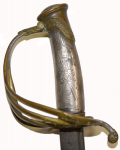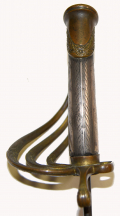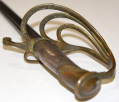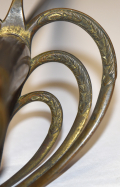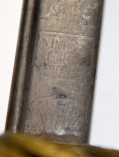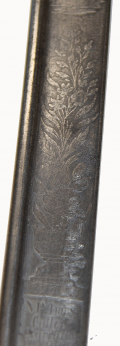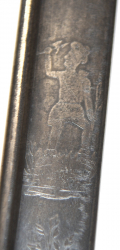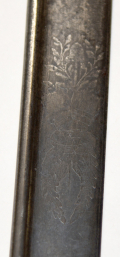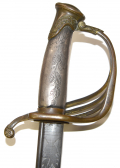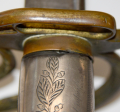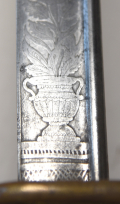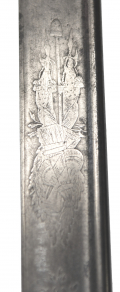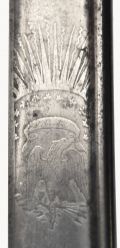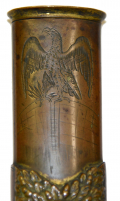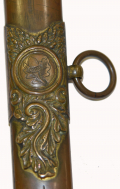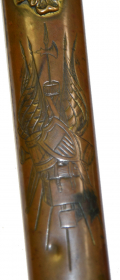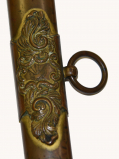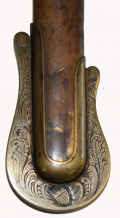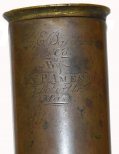site search
online catalog
VERY RARE AMES DRAGOON OFFICER’S SABER: 1850 LOUISIANA PRESENTATION TO JAMES R. BURNS, LATER LIEUTENANT COLONEL 35th TEXAS CAVALRY

$50,000.00 SOLD
Quantity Available: None
Item Code: 870-239
This rare dragoon officer’s saber was made by Ames and sold through H.E. Baldwin & Co. of New Orleans for presentation to Colonel James R. Burns of the Louisiana militia in August 1850. It was praised at the time as a “beautiful and costly sword” by the New Orleans Weekly Delta in their notice of the presentation. Burns was an attorney based in Lafayette, a suburb of New Orleans (annexed in 1852,) joined the newly created Lafayette Riflemen as their first lieutenant in 1847, and was their commander by January 1850. Later that year he moved to Texas, where he spent the rest of his life, and the sword would have been brought out again for his service during the Civil War, when he served as an Instructor of Tactics for early-war Texas volunteers, raised a battalion of Texas cavalry, and became Lieutenant Colonel of the 35th Texas Cavalry, serving with it under fire in at least four engagements in the repulse of Nathaniel Banks Red River Campaign in 1864.
THE SWORD
The sword itself is a rare high-grade version of the 1833 dragoon, using an 1840-style pommel and robust guard with the knucklebow and three branches of the 1839 Topographical Engineer sword rather than the two of an 1833 dragoon, along with the small reverse side loop common to them both. The top brim of the pommel cap is engraved in small block letters: “Always for justice. Never for oppression.” The lower edge of the pommel has a conventional cast and chased leaf border. The upper knucklebow and lower inner and outer sides of the guard branches, however, are deeply cast and chased with floral motifs and the scrolling quillon finial is notched and has a central rosette.
The sheet silver grip is engraved at top with feathery leaves coming out from under the pommel cap and decorative borders separating obverse and reverse panels. The obverse is engraved with a stand of arms including a U.S. shield and a liberty cap on a pole. The reverse has a branch of oak leaves and acorns with a motto along the upper edge: “Semper prompti et bene parati,” i.e., “Always prompt and well prepared,” which, being in the plural, is either the unit’s motto, or simply appropriate to an active militia unit.
The 1833-style pipe-back blade is etched on both sides. The obverse has a glory or sunburst of triangular rays and lightning bolts at the bottom, with a clipped corner cartouche above etched, “N.P. AMES / Cutler / Springfield.” Above that an urn sprouts a tall leafy plant, over which is an Indian with raised tomahawk, usually taken as Tecumseh. Three more floral sections follow, the lowest with wreath-like branches joining a the bottom and floral-entwined quivers with arrows and a pole with liberty cap. The reverse has a similar urn and tall plant at bottom and floral elements above, but has two principle central panels: one, a stand of arms surrounding a liberty cap on a pole; the second, a U.S. eagle with arrows and olive branch, flourishing a ribbon scroll, with stars and a glory sunburst overhead.
The brass scabbard is fitted with separate throat, two ring mounts, and a shoe-style drag. The throat is narrow, with flat top and mouth contoured for the pipe-back blade. Both ring mounts are deeply cast, chased and engraved on the obverse. Beneath the throat the scabbard is engraved with a very well rendered U.S. eagle perched on the upper half of a globe. The upper ring mount has cast and chased floral motifs with an acorn and oak leaf engraved in a central medallion that mirrors the reverse grip. The obverse grip is mirrored in the scabbard engraving between the ring mounts showing a stand of arms with flags, halberds, and U.S. shield, which is repeated in a small, partial stand of arms engraved on the lower ring mount itself, which is also deeply cast and chased with floral scrolls. The floral motifs are continued in the scabbard engraving as a dense series of leafy scrolls. The blade of the drag picks up a number of the previous motifs, using floral and leafy scrolls, an acorn terminal, and a U.S. shield.
The scabbard reverse is engraved at top: “H.E. Baldwin / & Co. / By / N.P. Ames / Cabotville / Mass.” The Ames address dates the sword itself to 1847 or earlier, the date when Nathan P. Ames died, the firm became the Ames Manufacturing Company and the address changed to Chicopee from Cabotville and Springfield. When it was shipped to New Orleans is not known, but the dating fits the establishment there of H.E. Baldwin and Company at 7 Chartres St. by the mid-1840s. This was run by Horace E. Baldwin as an off-shoot of the Baldwin jewelry making firm of Newark, N.J., and sold jewelry, watches, silverware, military and fancy goods, etc., until his death in 1852, at which point the business devolved upon Baldwin and Company, who sold off the inventory.
The presentation is done lengthwise on the scabbard reverse between the ring mounts in script and Old English with flourishes: “Presented by the Lafayette Riflemen / to their late commander / Col. J.R. Burns / City of Lafayette, La. / 1st August 1850.” The New Orleans Weekly Delta of 5 August 1850, reprints a notice of Saturday, August 3: “The Lafayette Riflemen, the crack uniform military company of our sister city, presented Col. Burns, their original commander, with a beautiful and costly sword, on Thursday evening. The company made Lieutenant Tucker the medium of the presentation. He acquitted himself very creditably on the occasion. The reply of Colonel Burns, too, was in excellent taste.”
COLONEL J.R. BURNS
Born 9 April 1822 in South Carolina, James Randolph Burns graduated from the College of Charleston in March 1844. The Texas State Hist. Assoc. states his father was a judge, which might explain some later political connections. The younger Burns followed suit, advertising as an attorney in Charleston in November 1844. He was in the local militia and by early 1845 was a lieutenant in the 16th Regiment. He left Charleston for New Orleans in late 1845, opening a law office in Lafayette. By 1849 the city directory lists him as a, “commissioner for the states of Ohio, Indiana, Illinois &c.,” indicating he was involved in settling bounty land claims made by veterans of the War of 1812, Indian Wars, and Mexican War. The post indicates political connections, supported by his election as Lafayette City Attorney in 1849.
Burns’s connection to the Lafayette Riflemen dates to the company’s formation in April 1847, though as their First Lieutenant, not the original commander. By January 1850 he was Captain. His designation as “late commander” and Colonel in the presentation may indicate a promotion that took him out of the company, but officers sometimes held simultaneous different ranks in the general militia and in a specific volunteer company. In either case, the rank implies a commission from the governor and fits his social standing and likely political contacts.
The sword may also have been a parting gift upon leaving New Orleans. By January 1851 he is in La Grange, Texas, advertising with L.F. and W.B. Price as attorneys at law, noting: “Particular attention given to the investigation of Land Titles and the collection of Mercantile Claims.“ He is also buying and selling land on his own account: in 1854 he advertises Texas land for sale in a New Orleans paper. There is no reference to militia or military service in Texas before the Civil War, but he was involved in bloodshed. In January 1860 Burns settled a dispute with a tenant farmer over cattle grazing by firing five shots from revolver, two of which took effect, and stabbing him seven times with a Bowie knife. Newspapers in the victim’s home state of Virginia indicate Burns fled and was later captured. He was indicted in August 1860, tried, and convicted of murder, but appealed for a new trial and before that could take place was pardoned in February 1861, presumably by Governor Sam Houston, another testimony to the value of powerful friends.
Wartime Governor Francis Lubbock was also exerted himself on Burns’s behalf with several letters of introduction and recommendation in Burns’s Confederate service records, which often use his rank of Colonel. Burns enlisted in 1861 in the Tate Guard, Co. A of Nichols’s Texas regiment. This was apparently as an enlisted man, but by March 1862 he obtained a commission as an “Instructor of Tactics” and although apparently instructing various new units at Galveston was attached as a 2nd Lieutenant to Elmore’s 20th Texas. He actively campaigned for a promotion to major or colonel as a rank appropriate to his duties, which involved the instruction of new officers as well as enlisted men. That promotion did not come through, and by late 1862 he was trying to organize his own company. By early 1863 he had gained a commission, as captain, or the promise of one, from General Magruder (in charge of the Department of Texas,) with permission to raise a company of cavalry and expand it to a battalion if he could. (It is a measure of his political savvy that he named his unit the “Magruder Light Horse.”) He proposed incorporating various stray cavalry companies in the state to form the battalion, or even a regiment, but in October 1863 was compelled to join his battalion of three companies with the battalion of James B. Likens and two companies of Terrell’s cavalry to form the 35th Texas Cavalry, with Likens as Colonel and himself as Lieutenant Colonel.
The regiment was almost immediately called into the field to help counter Union actions along the Texas gulf coast and from November 1863 until March 1864 was active south of Galveston, scouting and picketing around Matagorda Bay and the Matagorda peninsula against Union foraging and raiding parties, and keeping an eye on the Union garrison established at the port of Indianola. This changed with Banks’s Red River Campaign and pleas for reinforcements, particularly cavalry. As part of Duff’s brigade and Bee’s division of cavalry, the regiment moved over 350 miles to Lousiana, arriving time to take part in skirmishing and harrassing Banks’s forces, particularly during his withdrawal after the battles of Mansfield and Pleasant Hill. They are mentioned in the fight at Monett’s Ferry and even in an attack on Union gunboats and transports.
Toward the end of the campaign Burns felt compelled to offer his resignation, on May 13, 1864, due to his eyesight, which glasses could not remedy. By his own affidavit, supported by the regiment’s adjutant and major, he had recently commanded the regiment under fire on four separate occasions, where, “his conduct was at all time was that of coolness & bravery,” in Major Wortham’s words, but he, himself, lamented, “my conscience forbids that I further attempt to lead men upon the field.” He offered to again take a post as instructor new troops or in the reserves if necessary, but otherwise simply to resign.
His resignation was accepted and he returned to La Grange. The postwar years find him again in the practice of law and during Reconstruction his name appears in state papers related to the role of the courts. He seems to have retained his political connections: by 1880 he had moved to Galveston to serve at Assistant U.S. District Attorney. In 1890 he was in Houston as law partner with his son Eldon. Another son, Waller, eventually be appointed a federal district judge by Theodore Roosevelt. He died in Galveston April 10, 1892, and was buried in La Grange.
The sword is very rare in its own right, made by Ames, sold through a recognized New Orleans military goods dealer, and presented to and carried by a southern officer with an interesting history. The condition is excellent, with just scattered traces of gilt on the brass scabbard, and somewhat more on the hilt, but a matching aged patina over all showing it has been carried, but with no dents, bends or damage. All engraving is crisp and very well executed. The blade has a good edge and point. The metal is smooth and an even muted silver in color with very few age spots and readily visible etching. (Ex-Kevin Hoffman Collection.) [sr] [ph:L]
~~~~~~~~~~~~~~~~~~~~~~~~~~~~~~~~~~~
THIS ITEM, AS WITH ALL OTHER ITEMS AVAILABLE ON OUR WEB SITE,
MAY BE PURCHASED THROUGH OUR LAYAWAY PROGRAM.
CLICK HERE FOR OUR POLICIES AND TERMS.
THANK YOU!
Inquire About VERY RARE AMES DRAGOON OFFICER’S SABER: 1850 LOUISIANA PRESENTATION TO JAMES R. BURNS, LATER LIEUTENANT COLONEL 35th TEXAS CAVALRY
For inquiries, please email us at [email protected]
Most Popular
Historical Firearms Stolen From The National Civil War Museum In Harrisburg, Pa »
Theft From Gravesite Of Gen. John Reynolds »
Cavalry Carbine Sling Swivel »
Fine Condition Brass Infantry Bugle Insignia »
featured item
CONFEDERATE FIRST NATIONAL FLAG FROM ISLAND NUMBER TEN
This Confederate First National flag has a tight provenance going back to 1935, and before that an oral history as a war souvenir brought back from Island Number Ten by James William McLaughlin, a prominent Cincinnati architect who in 1861 had served… (1179-004). Learn More »






